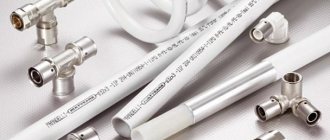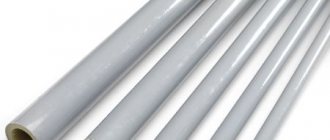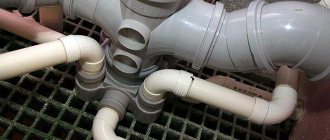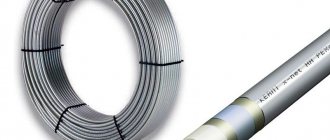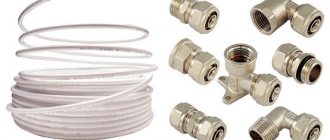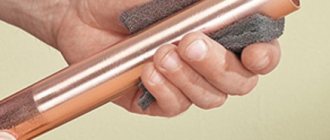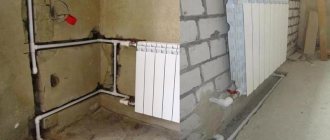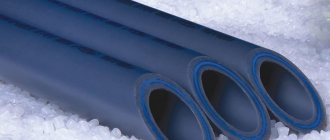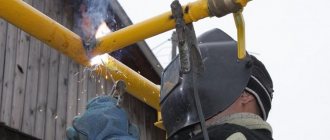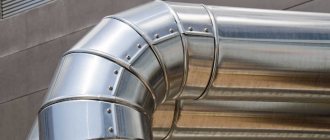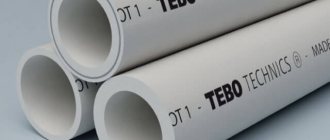Good day, dear reader! Due to its inherent shortcomings, rolled metal pipes have been used less and less in recent decades for wiring the heating systems of private houses and other buildings. Metal-plastic pipes for heating, thanks to the unique structure of the wall, are completely devoid of the weaknesses of metal products. They have anti-corrosion properties, a combination of flexibility with high strength.
Technical characteristics of MP pipes
The general technical characteristics of metal-plastic pipes, regardless of their manufacturer and geometric parameters, are:
- The permissible bending radius using the manual method is in the range from 80 to 550 mm, using a pipe bender - 50-180 mm.
- The maximum pressure level in the pipeline is 10 Bar at an ambient temperature of 95 degrees, 20 Bar at 20 degrees, the destructive pressure will be 80-94 Bar.
- The coefficient of thermal expansion is 0.026 mm/m per 1 ºC.
- Thermal conductivity coefficient is 0.45 W/mK.
Structural properties
MP pipes receive different properties depending on the barrier layer manufacturing technology used:
- Made from sheet aluminum foil. During production, an aluminum billet is welded into a metal-plastic pipe using ultrasonic welding. It is connected to layers of cross-linked polyethylene with adhesive layers. Products reinforced in this way have greater flexibility, but less strength and a small range of permissible operating temperatures.
- In the form of a rigid mesh frame welded from steel wire or strip. The metal frame is poured into the molten plastic of the inner layer, and then filled with molten plastic of the outer layer. With this manufacturing technology, there is no need to use adhesive compounds for gluing layers, which has a positive effect on the strength characteristics of products and the length of their service life.
Working temperature
Metal-plastic pipelines can be used at a constant temperature of the coolant in the heating system up to +95 ºC and for a short time at +110 ºC. Freezing of the working environment begins at -40 ºС.
Life time
Manufacturers usually indicate the service life of metal-plastic pipes for heating at an ambient temperature of +20 ºC is at least 50 years, at a temperature of +95 ºC - about 25 years.
In practice, durability is also influenced by the accuracy of compliance with established norms and rules when installing a heating system, and the conditions of its further operation.
The use of metal-plastic pipes in autonomous and central heating systems
The use of metal-plastic pipes for the installation of heating networks allows you to save time, effort and money and equip a pipeline that has all the positive qualities of metal and plastic.
To obtain such a result, you must, first of all, understand the differences in the operation of central heating and individual heating:
- In a central heating system, a powerful heat-generating device heats a large volume of water. The heated coolant enters houses and apartments at a temperature of 40 to 95 degrees, but with preventive measures, the water supplied to the pipes can have a temperature of up to 150 degrees. The pressure is usually in the range of 4-5 atmospheres, but since an extensive and branched heating network is serviced, water hammers occur in the pipeline - pressure surges when it exceeds the norm by 2-3 times. For metal-plastic, 95 degrees is the operating temperature limit, and water hammer is a threat of instantaneous destruction of the walls, especially at corners and nodes. Therefore, the installation of metal-plastic pipes in rooms receiving coolant from a centralized system is undesirable. However, the above problems can be solved by equipping the pipeline with pressure stabilizers and temperature regulators.
- A small volume of coolant circulates in an autonomous system; temperature and pressure can be adjusted directly on the heat-generating device. Therefore, in houses, apartments, commercial and other buildings with individual heating, metal-plastic can be used without restrictions.
We recommend that you read: Self-installation of a samovar-type heat exchanger on a chimney pipe
Design Features
Metal-plastic pipes are made of composite material and have a five-layer wall structure, where the inner and outer layers are polymer, an adhesive mass is used as two connecting layers, and the barrier layer is made of aluminum foil.
Aluminum layer thickness and connection method
The thickness of aluminum foil is usually 0.15-0.6 mm. The best option for arranging heating systems are metal-plastic pipes with a reinforcing layer thickness in the range of 0.3-0.55 mm. They have sufficient flexibility and strength.
In the production of metal-plastic pipes, laser or ultrasonic welding is used to join aluminum.
The joint is performed in one of the following ways:
- Overlapping. In the finished product, a seam is formed at the weld joint, therefore, in order to maintain the evenness of the surface, manufacturers reduce the thickness of the foil, compensating for the thickening.
- Butt. The edges of the aluminum foil fit tightly to each other and are connected without any thickening. The walls of the reinforcing layer are perfectly smooth along the entire length of the pipe.
Type of plastic in the inner and outer layer
To make the outer and inner layers in high-quality metal-plastic pipes for heating, the following types of plastic are used:
. During production, special crosslinking additives are introduced into the raw materials, giving the material improved mechanical characteristics and resistance to pressure and temperature changes.
. It has a unique molecular structure that allows this material to achieve high impact resistance, resistance to cracking during bending, and heat resistance over a wide range of operating temperatures (from -50 ºC to +95 ºC).
Products that use varieties of low-density polyethylene PEHD, PE-RS, PE and HDPE for the same purposes can be operated at temperatures not exceeding +75 ºС. When the parameters are exceeded, the plasticity and fluidity of plastics increases, which can lead to loss of integrity of metal-plastic heating pipes. In addition, products made from low-density polyethylene wear out quickly when exposed to ultraviolet rays, so they need to be insulated.
Bonding layer
Plastic and metal are combined with special compounds, the properties of which make it possible to combine layers of different materials into a single structure. The proportions of components in the composition of each company may vary, but the requirements for glue for safety for human health are strictly observed.
Adhesive layers not only act as a binding material, but are also responsible for the elasticity of metal-plastic heating pipes. When the glue loses its elasticity, the product delaminates and leaks occur. Therefore, when choosing such pipe products for heating, it is necessary to check the cut for the absence of delamination. The presence of delamination is a prerequisite that the heating system wiring assembled from such pipes will quickly fail.
Materials from which metal-plastic pipes are made
Metal-plastic pipes are made of metal and plastic layers laid one inside the other. Such products combine all the best qualities of the materials used. They are able to withstand high temperatures up to 95 degrees, are flexible and durable, which ensures reliability and durability of use.
The multi-layer structure was created and developed to prevent mechanical damage, air ingress and possible expansion of the pipe due to thermal effects. The appearance of rust, limescale build-up, scale and ulceration from aggressive substances is also completely excluded due to the ideal smoothness of the pipe cavity.
Metal-plastic pipes made of various materials Source glawtruba.ru
The surface of the pipe consists of a thermoplastic high-strength material, which provides it with high hardness and strength. It's called polyvinyl chloride, or PVC. The internal space is lined with a polyethylene layer. The aluminum shell is located in the middle, between these two layers. All layers are fastened together using an adhesive layer. The following types of plastic are used in production:
- polyethylene;
- polymer resistant to extreme temperatures;
- polypropylene;
- polyethylene that can withstand high pressure.
The glue firmly adheres the layers and makes the pipe solid, monolithic. The core of the pipe is made of metal reinforcement and is designed to provide temperature stability and additional strength. Despite their hardness, the products have sufficient elasticity, and the light weight of aluminum significantly reduces the weight of the pipeline. Thanks to its flexibility, the pipe can be easily given any desired shape.
Layers of metal-plastic pipes Source pechky.ru
Materials used to make pipes
Modern heating systems are assembled using pipes made of different materials:
- Carbon steel.
- Copper.
- Stainless steel.
- Metal plastic.
- Polypropylene.
The last two materials are relatively new. Here are their features.
Metal-plastic
Metal-plastic is a construction material consisting of a steel strip coated on both sides with a polymer film.
It has properties inherent in both plastics and metals. Metal-plastic is plastic, suitable for processing on mechanisms that produce pipe products.
Polypropylene
Polypropylene is a chemical compound developed specifically for the manufacture of plumbing products. It is light, elastic, durable, absolutely not subject to corrosion, frost-resistant, and inert towards chemically active substances.
General requirements for the operation of pipeline systems
During operation of pipe products made of metal-plastic, the following requirements must be observed:
- Heat sources with a heating temperature higher than +150 ºC should not be placed in close proximity to metal-plastic heating pipes.
- In case of fire, use sand to extinguish.
- Periodically inspect the joints of parts and, if necessary, tighten detachable connections.
- Do not use metal-plastic pipes for external communications; system wiring in unheated rooms must be protected from heat loss.
Purposes of using metal-plastic pipes
Metal-plastic pipes are used on a wide domestic and industrial scale, for example, in the construction of houses. Metal-plastic pipes are used for heating, water supply and sewerage systems. You can also use them to lay a structure for heated floors. In industrial areas, such pipes are used for gas pipelines and the supply of hazardous chemicals - liquid or diffuse.
Sometimes you can find unconventional uses of pipes, for example, as a mounting block in which wires and electrical cables can be laid and hidden. This method of insulation is safe and durable. Metal-plastic serves well in ventilation and air conditioning systems.
Warm floor made of metal-plastic pipes Source pol-spec.ru
Is it possible to use metal-plastic pipes for heating?
It is possible, since MP heating pipes can withstand higher temperatures compared to conventional polymer products, they are much more convenient to install and look more aesthetically pleasing. The presence of a metal layer in the material provides them with high oxygen impermeability, which reduces the risk of corrosion of other metal parts in the heating system.
Advantages and disadvantages
Metal-plastic pipes have the following advantages:
- Absolute corrosion resistance.
- Immunity to aggressive chemicals.
- High throughput. MP pipes for heating have smooth walls on the inside, which offer little resistance to the flow of the internal environment.
- Low electrical conductivity.
- Wear resistance of internal surfaces.
- High ring rigidity.
- Low thermal conductivity coefficient.
- Resistant to silting and water stone formation.
- Low specific weight, facilitating transportation and installation of pipe products.
- Higher strength than plastic counterparts under tensile, lateral and impact loads.
- Bacteriological resistance. Metal-plastic successfully resists the formation and development of mold, as well as fungal deposits dangerous to health inside communications.
- Easy to install Heating systems made from such products are easily assembled using fittings without the use of welding equipment.
- Good flexibility, allowing to reduce the number of connecting parts.
- More affordable price compared to the cost of pipes made of cast iron or copper.
- Aesthetic appearance - no need for painting.
The disadvantages include:
- There is a danger of leaks at the joints of parts that occur during temperature changes due to different linear expansion coefficients of plastic and metal interlayers. To avoid such situations, heating pipes are laid with a small allowance, and compensation loops are installed at bending points.
- Low frost resistance. External lines of heating systems must be thermally insulated, since frozen water can rupture MP pipes.
- Instability to ultraviolet radiation, therefore metal-plastic products cannot be laid in places where there is a danger of direct sunlight on their surface.
- High cost of connecting parts (compared to polypropylene pipelines).
- Risk of fatigue damage after several bends.
Advantages and disadvantages of metal-plastic pipes
Let's start with the advantages :
- The inner surface is smooth, so there is no precipitation or silting. Over time, the lumen of the pipe does not decrease. Therefore, the service life of MP pipes is long - up to 50 years at an ambient temperature of up to 20°C and 25 years at a temperature of 95°C. These terms are valid only for certified quality products.
- Lower noise level than metal pipes. Factor of. The noise in the risers of apartment buildings is very noticeable. By replacing them with MP pipes, you will hear practically nothing.
- Compared to unreinforced polypropylene pipes, the coefficient of thermal expansion is low. If we take PPR-reinforced pipes, then the indicators are comparable: more than those of metal pipes, but quite acceptable (for heating distribution, compensators or compensation circuits are required).
- They do not conduct induced currents.
- Lungs.
- High-quality raw materials are chemically neutral and such pipelines can be used for any environment. Including for supplying drinking water.
- Elastic. You can bend it without the risk of breaking the foil layer (if the seam is welded).
Metal-plastic pipes can be bent - Low thermal conductivity. This is very good for heating and hot water systems: during transportation the temperature drops slightly, which means we will get hot water, which is good both in the shower and for radiators.
Now the disadvantages :
- Plastics are flammable, so they are not allowed for fire water supply installations.
- Limited area of use due to temperature restrictions (ambient temperature up to +110°C, fear of freezing).
- Metal-plastic pipes (unlike PP) are afraid of defrosting - they lose strength and can crumble.
- They do not tolerate ultraviolet radiation well and are therefore unsuitable for outdoor installation.
- The presence of thermal expansion requires the installation of expansion joints in long branches.
- The fittings have such a structure that they narrow the lumen of the pipe. So the presence of a large number of fittings significantly reduces the throughput of the pipeline. One good thing is that MP pipes are sold in coils and you can lay long sections by bending the pipe in the right places, rather than installing fittings, as in PP pipes. But even in this option, a more powerful circulation pump is required than when installing polypropylene pipes.
MP fittings narrow the clearance and this is one of the main disadvantages - During installation, crimp, threaded or press fittings are used. The specificity of using MP in heating is such that even high-quality and perfectly installed connections begin to “drip” after a few years and need to be tightened. Therefore, if you decide to wall up pipes in the wall (a popular solution), you will have to make inspection windows in the places where the fittings are installed. If they are not done, you will have to break the walls (to eliminate the leak).
- If we compare the prices for MP and PP fittings, then MP are much more expensive (of the same quality level). But fewer of them may be needed - due to the fact that pipes can be bent.
Most of the disadvantages can be attributed, rather, to the features and rules of operation: hide from ultraviolet radiation, do not use for high-temperature environments, make compensators and protect from fire (flammability). But the rest are not very pleasant. The need to tighten connections is especially disheartening: sooner or later a moment comes when there is no room to tighten. And then there is only one thing left: change. First, the fitting, and then, possibly, the entire system.
Which heating pipes are better - metal-plastic or polypropylene?
On construction forums there is often a debate about which pipes are better for heating - polypropylene or metal-plastic.
When comparing the complexity of installation work, the cost of components, resistance to the influence of external and internal conditions on the durability of the system, you can choose a more suitable material for organizing heating:
- Installation methods. The joining of parts made of polypropylene is carried out mainly by soldering, but to form a contour from metal-plastic products, fittings are needed. There are never leaks in soldered joints, but connections using fittings are less reliable and can leak due to differences. Therefore, it is not advisable to hide metal-plastic in the wall.
- Flexibility. Metal-plastic pipes easily bend in any direction, which is impossible to do with rigid polypropylene products. With a complex configuration of the heating system and installation of its elements in hard-to-reach places, it is much more difficult to form a polypropylene turn.
- Coolant temperature. The favorable temperature regime for the operation of polypropylene products is up to 75 ºC, while metal-plastic can function at +95 ºC and can withstand +95 ºC for a short time.
- Cost of components. Polypropylene is approximately 2 times cheaper than metal-plastic, the difference in price is especially noticeable for connecting parts.
Choosing metal-plastic pipes for installing a heating system
To begin with, before choosing an MP pipe, you need to decide for what purpose you plan to use it. If this is a centralized heating system, then the pressure in such networks usually does not exceed 4 atmospheres. For autonomous networks, this figure almost never exceeds 1.5 atmospheres. It is also necessary to take into account temperature indicators, which do not exceed 70-90 degrees. Most modern boilers have the option of monitoring and regulating the coolant temperature.
All these indicators indicate that MP pipes can be used to build a heating system. When choosing metal-plastic for the construction of a heating system, one important parameter must be taken into account - this is the low linear expansion rate. If you plan to constantly heat the house, that is, maintain the water temperature in the system above 20 degrees, then the material can be used. If there are changes in coolant temperature, the pipes will fail very quickly, so they will need to be replaced.
If a solid fuel boiler is used as a source of heat injection, in which there is no option to control the temperature of the coolant, then it is possible that the temperature values may increase above 90 degrees. To prevent a critical rise in temperature, it is recommended to use heat accumulators, otherwise the pipes will quickly fail.
In conclusion, it should be noted that only after choosing the appropriate diameter of the product, you will also need to buy fittings for the pipe. These are connecting elements due to which two pipes are connected, as well as changes in direction, transitions, etc. MP fittings are not cheap, so when choosing between metal-plastic and plastic for constructing a heating system in a house, you need to immediately weigh all the advantages and disadvantages, and only then make the appropriate, correct and competent choice.
Selecting a heating scheme
The choice of a heating scheme where MP pipes are used is based on factors such as:
- Type of heating device and its location.
- Electrical connection.
- Number of floors, building dimensions and layout features.
- Water supply entry point.
- Coolant circulation method (natural or forced circulation type).
From the point of view of pipe routing, heating schemes are classified into:
- Single-pipe - effective for small building areas.
- Two-pipe - two pipes are connected to each radiator (supply and return risers). The heated coolant, under the action of the pump, moves from the boiler to the battery, where it gradually cools. The cooled liquid returns to the boiler through a separate riser (return), no longer coming into contact with the heated coolant.
- With bottom or internal wiring.
- Collector. They are expensive in terms of the amount of material, but they allow you to regulate the heating temperature of each element individually.
- With floor-to-floor wiring and others.
Video description
The secret of connecting metal-plastic pipes
With the open installation method, the pipes are laid directly along the wall or along the floor. This method is used when it is impossible to hide the pipes. But since the appearance of the pipes is quite aesthetic, this method is widespread and is a budget option. Among other things, open installation is very convenient for repairing pipes and maintaining cleanliness. In case of combined installation, pipes are sealed with plastic panels or special boxes made specifically for the required size.
First, installation locations are outlined and measurements are taken. The pipes are cut to the required length. The resulting cut elements are laid out on the markings made. Next, the metal-plastic pipes are connected with fittings. To decide how to connect a metal-plastic pipe to each other, you need to understand which method will be the most convenient. The connection is possible in a detachable (collapsible) or permanent (iron coupling) way.
Fittings for connecting metal-plastic pipes Source banyabest.ru
The detachable method is very convenient and is carried out using a collet connector, which has a spring bushing. This fitting is expensive, but if necessary, it can be disassembled and used again. It is made of brass alloy and is secured with a ferrule inside the housing. Also, a compression connecting element can be used for this method.
The process of connecting pipes is as follows. A nut and collet are put on the pipe. A fitting is inserted inside the pipe, onto which the union nut is screwed. The same is done with the second pipe. This results in a strong and reliable connection.
A one-piece connection method is possible when using push fittings and press fittings. The connection of metal-plastic pipes can be angular, straight or triple. In order to decide how to connect metal-plastic pipes, it is advisable to take into account the installation location.
Pressure testing of a metal-plastic pipe Source lammin.org
A simple connection method includes crimping metal-plastic pipes. This method is also called a crimp connection. For this activity you will need crimping pliers, a fitting, a ferrule and a union nut. Pressure testing is often used in laying heated floors using a press fitting, or for cold water supply, where a compression fitting is used. Control holes in the form of windows are made for hidden installations. The water supply is attached to the wall with clamps or clamps. If it is used in a heated floor system, then fixation occurs in special underlay mats.
Tips for choosing
The best models of metal-plastic pipes for assembling heating systems will be products that have:
- The connection of the aluminum barrier layer is made by butt welding.
- The foil layer has a thickness ranging from 0.3 to 0.6 mm.
- The inner and outer layers are made of PEX or PE-RT polyethylene; other types of plastic reduce the durability of the products.
- There is no delamination at the pipe cut.
Diameter
Pipes with an outer diameter of 26 mm, an inner diameter of 20 mm and a wall thickness of 3 mm (26x20x3) are suitable for arranging heating systems in private houses working with low-pressure flows, as well as heated floors.
In individual heating systems and utility networks for industrial use with an increased level of medium pressure, it is necessary to install pipes with a higher throughput - 40x32x3.9 mm.
How not to buy a fake
Unfortunately, not only high-quality but also counterfeit products are sold on the building materials market. In order not to buy a fake, you need to first select a well-known manufacturer and study information about the features of the products they produce, namely:
- The color of the outer and inner layer of polymer material.
- Texture (smooth or rough).
- Range of diameters.
- Product brand.
- Type of marking.
You should only make a purchase in a specialized store, where you can view the certificate and inspect the product for compliance with the specified criteria. Often, just by the external signs and clarity of the markings, you can identify a fake.
You should pay attention to the cut of the pipe. Most large companies weld the barrier layer end-to-end; an overlap joint is a characteristic feature of low-quality products. The thickness of the layers should be the same along the entire length of the metal-plastic heating pipe, and the inner surface should be even and smooth.
What is the thickness of foil in metal-plastic pipes and what does it affect?
Today, every house and apartment has plumbing or heating systems made of metal-plastic. Moreover, metal-plastic pipes are so easy to use that their installation can be done by hand without the help of specialists. If we compare them with plastic, then to solder them you will need an experienced soldering specialist, and the situation is similar with metal material - it is impossible to build a heating or plumbing system without a welder.
In the design of MP, aluminum foil is considered one of the main components. The absence of foil makes the material a regular polymer. Many people do not know why the foil layer is needed, even when they prefer metal-plastic pipelines. The aluminum layer is assigned a number of tasks:
- Protects against various influences, and not only mechanical ones. Foil in MP pipes prevents destruction of the material under mechanical stress, bending, and pressure changes inside.
- Protects against linear extensions.
- Acts as an oxygen barrier.
Modern manufacturers produce MP pipes in which the aluminum layer has different thicknesses - from 0.15 to 0.6 mm. The larger the layer, the more reliable and efficient the design. Often, when it is planned to build a heating system from metal-plastic pipes in a private house, the cheapest metal-plastic products are purchased. However, their cheapness is not justified by their quality, because the final cost is affected by the thickness of the foil.
It is highly not recommended to buy pipes in which the foil thickness is less than 0.3 mm, especially if you plan to build a heating system or a water supply system with a pump. Such materials are very fragile, and at the slightest excess of the bending angle, they break.
If you need high-quality and reliable materials, it is recommended to use devices with a foil thickness of at least 0.3 mm. These are flexible and reliable pipes that are easy to work with and have a fairly long service life. The smaller the thickness of the foil, the lower the service life, so a 50-year resource is the standard for pipes that are manufactured in accordance with GOST and using a foil layer with a thickness of 0.55-0.6 mm.
Main manufacturers
The largest European manufacturing companies producing metal-plastic pipes for heating and components for them are:
- Italian. Valtec pipes (PEX/AL/PEX) use granulated high-pressure polyethylene with a cross-linking degree of 65% for the manufacture of internal and external layers, which gives them strength and ductility in an optimal ratio.
- Belgian. For the manufacture of the inner and outer layers, cross-linked polyethylene PE-Xc is used, the reinforcing layer is made of aluminum foil with a thickness of 0.4 mm and is connected in a butt manner. Two connecting layers - special glue. The operating temperature of metal-plastic products is 95 ºC; short-term operation is allowed at 110 degrees.
- Oventor (Germany) is a manufacturer with extensive experience, producing about 400 types of products for the installation of engineering communications for any purpose.
Not inferior in quality to Russian products. Their Classic metal-plastic heating pipes are in great demand among consumers, as they are produced in compliance with technical and hygienic standards, have high strength and reliability, bend well and are easy to install.
Pros and cons of metal-plastic pipes
A pipeline made of metal-plastic mains will last up to fifty years. If it is used in a hot water supply network, its service life reaches twenty-five years. All engineering communications operate absolutely silently. Other additional benefits include:
- flexibility and elasticity - allow you to fix the pipeline without the use of individual parts (angles and connecting devices);
- immunity and resistance of pipe shells to gases and aggressive chemical composition;
- absence of corrosion damage;
- tightness;
- little weight;
- convenient transportation due to the compactness of the products;
- ease of installation;
- beautiful aesthetic appearance;
- low acceptable cost;
- environmental friendliness and safety for the health of animals and people;
- low thermal conductivity - you can’t get burned;
- waste-free.
Installation of a metal-plastic pipeline Source saw-wood.com
Along with the undoubted positive characteristics, there are also some disadvantages in using metal-plastic pipes for water supply. They cannot be bent or unbent repeatedly in the same place. This leads to internal damage to the composite shells. Twisting in a circle is not possible. In addition, delamination can also occur in poorly manufactured products. When using pipes at sub-zero temperatures, additional thermal insulation is required.
Also, the disadvantages include the impossibility of using the pipe in too hot conditions (if the temperature can reach 150 degrees). The pressure in the hot medium working pipe should not exceed ten bar.
In addition, metal-plastic is not suitable for heating when installed in a central network. This is due to the fact that when carrying out preventive measures, the water can reach a temperature of one hundred and fifty degrees. Only strong metal structures can withstand such a water hammer. Failure to comply with this recommendation may lead to damage and subsequent destruction of the metal-plastic heating pipe. Such troubles can be avoided by additionally integrating a temperature regulator and a pressure stabilizer.
Metal-plastic pipes for water supply Source alfatep.ru
Selection of fittings
The heating system can have different configurations and includes many components: boiler, radiators, shut-off and control valves, etc. All of them are combined into a single structure using pipes of different diameters.
Fittings are used as connecting elements. There are several types of them for metal-plastic:
- Detachable.
- Compression.
- Crimping.
- Press fittings.
Detachable
Detachable are the connecting pipeline parts that, if necessary, can be repeatedly disassembled and reassembled.
These include collet and threaded fittings:
- Tees.
- Crosses.
- Corners.
- Adapters, etc.
To ensure the tightness of connections with threaded type fittings, flax strands or FUM tape are used; in collet parts, this function is performed by a sealing ring - collet. It is installed as follows: a nut is put on the calibrated mounting end of the metal-plastic heating pipe, then a collet, after which the housing is pushed all the way. Next, an o-ring is threaded onto the outlet pipe of the housing, which is pressed with a nut. It is tightened first with your hands and then with a wrench.
If the nut is not tightened enough, then leaks are possible at the connection point, but even with excessive force, the nut can be overtightened and damaged. In addition, such a fitting cannot be embedded in a wall, since during prolonged use the nut may become loose and will have to be tightened.
Compression
This type of connecting elements consists of:
- Union nut.
- Fitting.
- Cut ferrule ring.
During installation, the nut and cut ring are removed from the fitting and placed on the end of the pipe. Then lubricate the fitting with silicone grease and insert it into the metal-plastic pipe. The connection is tightened using a nut by hand and a wrench.
Press fittings
Press fittings form permanent connections. They are installed using special tools:
- Hydraulic press machines with microprocessor control.
- Manual press pliers.
This method of joining parts is highly durable and reliable, so it can be used for laying heating lines in concrete structures.
Components for press connection pipelines are of the following types:
- Tees are transitional and with fastening.
- Couplings.
- Squares.
Crimping
The design of the fitting that forms a rigid crimp connection includes the following elements:
- Union.
- Crimp coupling.
- Dielectric gasket.
The coupling can be made of brass or steel; it is pressed around the pipe using press pliers, eliminating leaks. The dielectric gasket prevents charge from accumulating due to the potential difference between the plastic of the top layer of the metal-plastic pipe and the brass.
Preparation and assembly of connections on fittings
First of all, we should mention calibration - a procedure that is sometimes neglected even by professionals. Meanwhile, metal-plastic pipes come from the factory in coils, and therefore, without calibration, they retain some ovality, which can then come out sideways. After all, when a fitting is inserted into a curved pipe, its O-rings simply tear out of the grooves, moving towards the fitting body.
We recommend: How to install a heat meter for a house with central heating?
All this leads to a decrease in the tightness of the connection, since the polyethylene sheath must be pressed directly against the fitting with rings. Moreover, polyethylene will inevitably soften when heated and be partially displaced from the area under the split ring. This means that if the O-rings are not in place, a leak may occur. The latter is usually easy to fix by tightening the nut, but sometimes not.
Installation of metal-plastic pipes
Let us add that with mandatory calibration, pipes with compression fittings can be laid openly. However, when such pipes are embedded in screeds or grooves, it is better to use press fittings.
If we talk about assembling heating systems, then, of course, there are few subtleties in this matter. When installing steel pipes, threaded connections are usually used, which are wound with plumbing flax. Such products are cut with a grinder or a hacksaw. The need for calibration and deburring and chamfering is not canceled. In addition, a jumper is required directly in front of the ball valves that shut off the radiator. Otherwise, the throttle or tap will regulate the flow of the entire riser.
When tightening the nut on a compression fitting, its body should be held with another wrench, otherwise you may accidentally break the tightness of previously made connections. Do not forget that turns of the heating line are made using special corner fittings, and not by bending the pipe. With a small radius, you may simply break the aluminum core, and too large a radius will look sloppy. When connecting the liner to the radiator, it is better to use special nuts - American ones. This connection allows you to quickly disconnect the heater if necessary.
YouTube responded with an error: The request cannot be completed because you have exceeded your quota.
- Related Posts
- How to choose a microprocessor controller for two pumps of a central heating pump?
- How to install a heat meter for a house with central heating?
DIY installation features
Do-it-yourself heating system installation begins with installing the boiler. If it is gas, then it must be installed by qualified workers of the relevant services.
The next stage will be the installation of radiators, heated towel rails and other elements of the heating system. Metal-plastic or cast-iron radiators are hung on the walls using special brackets. Under them, holes are drilled in the walls into which anchor bolts are screwed.
After this, you can proceed directly to laying the pipes.
Necessary tools and components
To assemble a heating system circuit with your own hands, you need to prepare in advance a set of tools consisting of:
- Pipe bender - to create an even cut line without burrs, scuffs or damage to the protective coating.
- Calibrator and chamfer - tools to ensure cutting of the desired shape and flaring of the pipe without deformation of the seals.
- Open-end or adjustable wrenches. For tightening threaded, compression and push-in fittings.
- Crimping pliers. For making connections with press fittings.
- Electric tool.
It is also necessary, according to the project, to prepare a sufficient number of fittings, fasteners (clamps and clips), shut-off and control valves.
Connection methods
It is better to connect the parts of the heating system in one of the following ways:
- Compression fittings - when the gasket is open.
- Press fittings or crimp couplings - for hidden installation.
How to bend a pipe
In places where the metal-plastic pipeline changes its direction, fittings can be installed, but such a technique will increase the cost of the structure.
It is more economical to simply bend the pipe in one direction or another with your hands or use an external or internal mandrel in the form of a spring, a hair dryer, or a pipe bender for these purposes. In this case, the bending radius should not be less than a value equal to 7 diameters of the connected product. If this parameter is less, you need to install an angle fitting.
How to connect metal-plastic pipes with metal ones
To connect to metal pipes or to the outlet pipes of a water heating device, a special coupling with one threaded type connecting pipe is used. This fitting is initially screwed onto the mounting end of a metal part equipped with an external thread.
The joint is sealed with tow and paint.
The other side of the coupling, where the metal-plastic pipe is connected, may have a sliding washer or a press fitting.
How not to make a mistake with the diameters of heating pipes - which diameter to choose
Heating designers are faced with the question, “What diameter pipes to use...” Speaking from the designer’s point of view, this question is extremely complex, as it requires cumbersome calculations taking into account many parameters, including thermal expansion, the effect of convection, changing system clogging and etc.
But if you look at the question “What pipe diameter to choose for heating” from a practical point of view, namely: “How to ensure high-quality and reliable long-term operation of the system,” then it turns out to be extremely simple. And solving it using a rule in a few words is extremely easy. In this case, there will be no 100% error.
What pipes should you choose?
Heating in houses is created either by polypropylene pipes or metal-plastic (plastic). Metal-plastic can also be understood as simply flexible plastic pipes without a metal layer, which can be replaced with an oxygen-resistant layer such as EVOH.
Polypropylene in general is much cheaper due to its fittings. But it has thicker walls. With similar internal diameters to metal-plastic, the outer diameter of polypropylene is significantly larger. For example, with an internal diameter of 12-14 mm, the outer diameter of metal-plastic will be about 16 mm (“16th pipe”) and for polypropylene about 20 mm (“20th polypropylene”).
But these pipes will be approximately equal in their hydraulic resistance in the system. Thus, the “16th pipe” and the “20th pipe” are interchangeable.
What diameters are found?
Only a few specific pipe diameters can be found on sale. They are designated by outer diameter. In this case, the internal diameter can vary within certain limits, depending on the wall thickness, which can vary depending on the manufacturer, the purpose of the pipe...
- For metal-plastic pipes, the outer diameters are: - 16 mm, 20 mm and 26 mm.
- For polypropylene pipes - 20 mm, 25 mm and 32 mm.
In terms of internal diameter (as well as throughput) they turn out to be approximately similar:
- 16 mm metal-plastic and 20 mm polypropylene (inner diameter approximately 12 - 13 mm). And so on, similar in throughput respectively - 20 mm metal-plastic and 25 mm polypropylene, as well as 26 mm metal-plastic and 32 polypropylene.
Is a project needed to determine the pipe diameter?
For heating, only pipes with an outer diameter of 16 mm, 20 mm and 26 mm can be used. You will have to choose from these diameters. Is this choice really worth making an expensive project? Of course not.
The simplest rules for choosing pipe diameters allow you to resolve the issue instantly and free of charge with a full guarantee of the correct choice. Pipe diameters are taken literally during installation by specialists without any calculations.
You may have to overpay a little by accepting a larger pipe diameter for a few meters, but such a tiny overpayment cannot be compared with the costs of labor, time and money to create a home heating project.
How experienced and inexperienced installers choose pipe diameters
Below is the outer diameter for metal-plastic.
- To connect the last two radiators, you can use a minimum pipe diameter of 16 mm. The same is true for taps (including long ones) for connecting one or two radiators.
- An arm of 3 – 6 radiators is connected with pipes with a diameter of 20 mm.
- The ring or line supplying 7 to 20 radiators is made from a 26 mm pipe.
For example, let’s connect 12 radiators in a house.
- The main line from the boiler is 26 mm.
- In the boiler room and utility room you need to install 2 radiators; we connect them with 16 mm taps from the main line.
- We make a branching on the left and right shoulders of 5 radiators in each with a 20 mm pipe. In this case, each radiator is connected with 16 mm taps, and the line to the last two is also 16 mm.
Perhaps the project for this house will indicate that a 16 mm pipe can be used to connect not the last 2 radiators, but 3 or 4.
In what cases can you not do without a project?
It is better to develop a heating project for houses with an area of more than 300 - 350 sq. m.
- Firstly, with such a volume of construction, the cost of the project will not stand out too much and will be appropriate.
- Secondly, it is better to link the many points where radiators should be placed into a single system using automated calculations.
In this case, the main thing is not the choice of pipe diameter, but the correct distribution of thermal energy throughout the large building and ancillary separate buildings...
What pipes to use if you do the heating yourself
When creating heating with your own hands, polypropylene pipes are most often used, as they are the easiest to install and the cheapest. Moreover, 90% of the cheapness lies in fittings, which are made of plastic and connected to pipes by soldering. It is worth remembering that polypropylene does not guarantee correct installation, even if the best professional in the world works, due to possible violations at the welding site. The most unpleasant thing is the overlap of the internal section with sagging. However, most small workable heating systems are made from PN-25 reinforced polypropylene pipe.
Another rule for choosing the diameter of pipes, you can calculate
The table shows the thermal power, W (below it is the amount of coolant in kg/min), depending on the speed of the liquid.
The optimal speed is considered to be 0.4 - 0.7 m/s, at which there is no noise and no overload of the pump.
According to these data, it is not difficult to notice that a couple or three standard ten-section radiators can be connected with a diameter of 16 mm (external metal-plastic, internal - 13 mm), etc.
